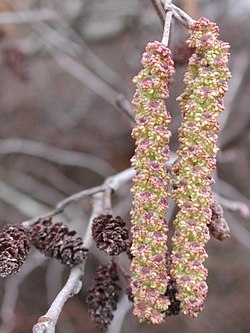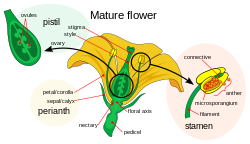Flowering plant sexuality
Flowering plant sexuality describes some of the technical terms for common arrangements of flowers.[1]
Flowers
Terms for the sexuality of individual flowers:
- Unisexual: Reproductive structure that is either functionally male or functionally female. In angiosperms this condition is also called imperfect, or incomplete.
Individual plants

Many plants have complete flowers with both male and female parts, others only have male or female parts, and still other plants have flowers on the same plant that are a mix of male and female flowers.
Some plants even have mixes that include all three types of flowers, where some flowers are only male, some are only female and some are both male and female.
A distinction needs to be made between arrangements in single plants versus the larger plant population.
Some plants also undergo what is called sex-switching, like Arisaema triphyllum which express sexual differences at different stages of growth. In some arums smaller plants produce all or mostly male flowers and as plants grow larger over the years the male flowers are replaced by more female flowers on the same plant. Arisaema triphyllum thus covers a multitude of sexual conditions in its lifetime; from nonsexual juvenile plants to young plants that are all male, as plants grow larger they have a mix of both male and female flowers, to large plants that have mostly female flowers.[2]
Other plant populations have plants that produce more male flowers early in the year and as plants bloom later in the growing season they produce more female flowers. In plants like Thalictrum dioicum all the plants in the species are either male or female.
Specific terms are used to describe the sexual expression of individual plants within a population.
- Monoecious, an individual that has both male and female reproductive units (flowers, conifer cones, or functionally equivalent structures) on the same plant; from Greek for "one household".
Individuals bearing separate flowers of both sexes at the same time are called simultaneously or synchronously monoecious. Individuals that bear flowers of one sex at one time are called consecutively monoecious; plants may first have single sexed flowers and then later have flowers of the other sex.
Protoandrous describes individuals that function first as males and then change to females; protogynous describes individuals that function first as females and then change to males. - Dioecious refers to a plant population having separate male and female plants. That is, no individual plant of the population produces both microgametophytes (pollen) and megagametophytes (ovules); individual plants are either male or female.[3] From Greek for "two households". Individual plants are not called dioecious; they are either gynoecious (female plants) or androecious (male plants).
- Androecious, plants producing male flowers only, produce pollen but no seeds, the male plants of a dioecious population.
- Polygamy, plants with male, female, and perfect (hermaphrodite) flowers on the same plant.[4] A polygamous inflorescence has both unisexual and bisexual flowers.[5]
- Trimonoecious (polygamous) - male, female, and hermaphrodite floral morphs all appear on the same plant.
Related pages
References
- ↑ Molnar S. 2004. Plant reproductive systems
- ↑ Ewing J.W. & Klein R.M. 1982. Sex expression in Jack-in-the-Pulpit. Bulletin of the Torrey Botanical Club 109 (1): 47-50. doi:10.2307/2484467
- ↑ "Angiosperm sexual systems". Archived from the original on 2011-11-04. Retrieved 2011-02-20.
- ↑ Geber, Monica A. (1999), Gender and sexual dimorphism in flowering plants : with 29 tables, Berlin: Springer, p. 4, ISBN 3540645977
- ↑ Davis, P.H.; Cullen, J. (1979), The identification of flowering plant families, including a key to those native and cultivated in north temperate regions, Cambridge: Cambridge University Press, p. 106, ISBN 0521293596

